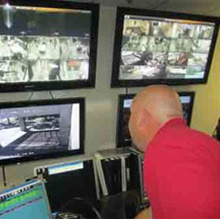 |
| More than 900 fixed and PTZ video surveillance cameras are installed throughout the GHS locations |
Upgrading the video surveillance and physical security system of a multi-building, multi-campus medical facility to state of the art status takes more than simply adding or changing equipment. It takes ingenuity and perseverance from the client, combined with experienced technology partners who can provide quality products and services that enable the client’s vision to become a reality.
A solution that measures up
At South Carolina’s Greenville Health System (GHS), Chief of Police and Director of Security Shawn Reilly had that vision - and a host of technology partners including OnSSI provided the solutions that helped him achieve his goal of implementing a leading edge integrated video surveillance and security system that was on par with the status of the facility.
One of the largest healthcare systems in the Southeast, Greenville Health System consists of five medical campuses and more than 100 off-site facilities that provide integrated healthcare to communities across the county. It is also home to the University of South Carolina School of Medicine Greenville, one of the nation’s newest medical schools. Recent honors for this well-regarded organisation include being named one of the Top 100 Integrated Healthcare Networks, Top 50 Teaching Hospitals and 10 Best-Led Hospitals. GHS’ vision is not only to transform healthcare for the people and communities it serves, but to ensure the safety and security of its patients, along with more than 1,200 affiliated physicians and nearly 18,000 employees and contractors.
A work in progress
Because of the scope and variety of facilities encompassed by GHS, enterprise-level solutions were needed to upgrade the overall security system and bring it together under a more controlled and managed environment. Access control had to integrate with video surveillance, both analogue and digital, and these foundational security systems had to then interoperate with ancillary security systems such as alarms, fire systems, an infant protection system and so on. Working with their integration partner Tech Systems of Duluth, Georgia, GHS and Reilly were able to implement a work-in-progress strategy that included upgrading or installing new systems throughout the entire GHS operation over the course of a seven year period in addition to installing a new fibre optic backbone.
While adding to and updating the video surveillance system to a network structure was deemed crucial for the protection of staff, patients, students and visitors to the many GHS facilities, as the system grew and became more sophisticated it also became necessary to have unified system control and management. For this aspect of the project, a video management system was recommended.
“Having worked with us through several upgrades and implementations, the status of our situation was well understood by Tech Systems,” said Mr. Reilly. “We needed a system that would provide improved video control and management and be easy for our dispatchers to learn and use. They presented several options and the OnSSI system was selected as the right fit.”
"OnSSI’s Ocularis is a dynamic solution and we are continually learning about new features that will help us improve the overall safety and security of GHS. It is a work in progress" |
Enhanced control improves security
More than 900 fixed and P/T/Z video surveillance cameras are installed throughout the GHS locations including at all alarmed doors, in locations such as pharmacies or nurseries that are equipped with panic buttons, and in parking facilities. An additional 25 cameras have recently been installed in the Health Sciences Education building which houses the USC School of Medicine Greenville.
The video management system enables dispatchers to view any of the cameras by simply executing a point and click on the map overview or, at the point of alarm, go to an immediate visual assessment. Previously, GHS security personnel were obliged to respond to alarms with no advance information of the situation. In remote facilities that are closed at night or only minimally staffed, dispatchers at the central command can conduct video tours rather than relying on traditional guard tours, saving both time and expense. And, with the large number of cameras on the GHS shared network, system operators can select bandwidth usage rates to minimise communication issues.
Recorded video is stored up to 30 days and can be viewed instantly and simultaneously with live video. On-board analytics provide additional investigative tools and time-slicing helps narrow down time frames when reviewing incidents. According to Al Harrison, a GHS law enforcement service investigator, having such comprehensive control of the video system is like having another partner on the team.
He says, “It’s much more effective to be able to police in a controlled environment. With this configuration, we’ve been able to quickly prove that a car was already damaged when it was parked in our lot or that a parking gate did not malfunction and accidently strike a visitor. Using the analytics and zoom features of the system we could prove otherwise and reduce our liability.”
Exporting video is another task that has been made easier for the GHS investigative team. For example, Mr. Harrison reports that when a gunshot victim arrives in the emergency department, local law enforcement can review a copy of the arrival portion of the video to see who may have brought the victim to the hospital or other evidence that may help solve a crime. GHS staff can conveniently export video material that is relevant to the investigation without compromising anyone’s privacy.
Value beyond security
OnSSI's Ocularis video management software platform has been in operation at GHS for about one year and has quickly become the go-to tool for the security staff. In addition to improving security and liability concerns, it is proving its worth in loss prevention and risk management areas.
Mr. Reilly adds, “OnSSI’s Ocularis is a dynamic solution and we are continually learning about new features that will help us improve the overall safety and security of GHS. It is a work in progress.”






